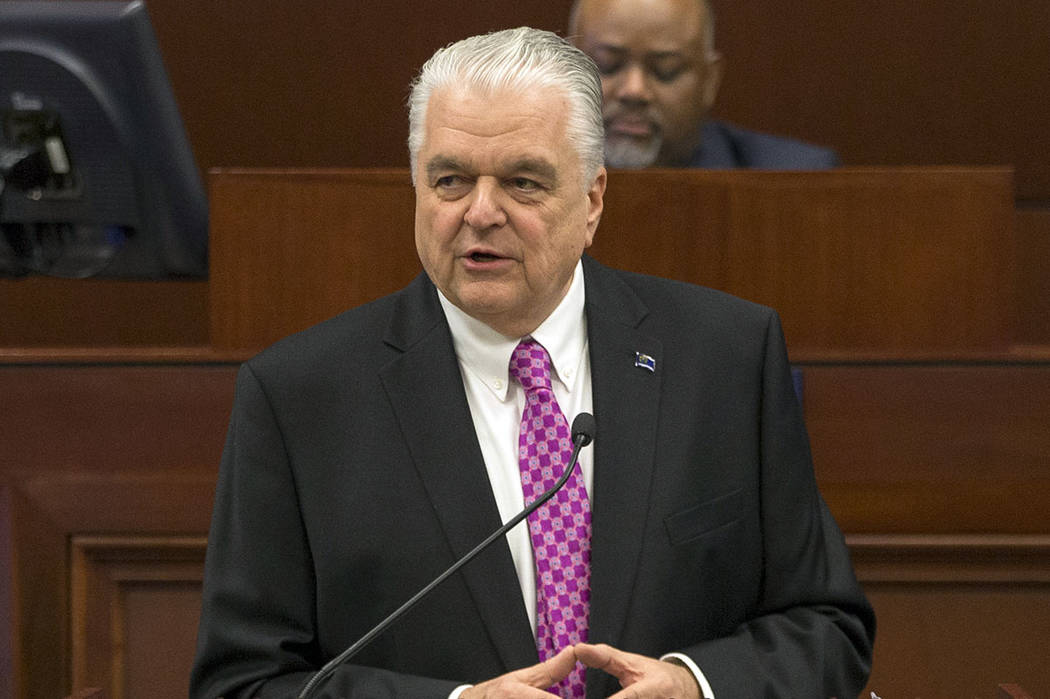Sisolak takes advantage of economic recovery with budget proposal
CARSON CITY — Gov. Steve Sisolak’s proposed state budget for the two years beginning July 1 represents the largest increase, in both revenues and expenditures, since before the Great Recession.
As recommended by the governor last week, general fund spending would increase 11.8 percent, or $946 million, over the biennial budget the Nevada Legislature approved in 2017.
That’s not as big as the $1.3 billion spending hike lawmakers approved in the 2007-09 cycle — just before the recession hit — a lavish 21.5 percent boost over the previous cycle.
Two years later, after the bottom fell out, the state had to knock general fund spending down by 11 percent, to $779 million.
Sisolak, in unveiling his spending priorities during Wednesday’s State of the State address, acknowledged that roller-coaster ride, noting that recent history “tells us what pain an economic downturn can bring.” Early in the speech he flagged his commitment to the continued care and feeding of the state’s rainy day fund as part of a balanced budget he developed “without any new taxes.”
On that last piece, a debate is emerging on what “new” means.
Putting that aside for the moment, the governor had the good fortune to ride into office on the crest of an economic wave that is forecast to push state revenue 7.2 percent higher over the next two years, or $591 million.
He’s looking to make good on campaign pledges to boost spending on education and health care. Those are the two largest individual categories of general fund spending, comprising 84 percent of that total budget. Increased allocations for both represent 90 percent of the $946 million in proposed new spending.
Not all of those increases come at the governor’s discretion.
While Sisolak did propose an additional $180.6 million to fund 3 percent raises for K-12 staff — the first for that group since that 2007 budget bonanza — the state also has to fund potential 1.3 percent enrollment growth at a cost of $127 million.
Similarly, on the health and human services front, while the budget includes more discretionary money for Meals on Wheels, family planning and autism treatment and assistance, far more of the increase in that area is due to declining Medicaid reimbursements, caseload growth, and rate increases for prescription drugs, hospice care and treatment costs.
Those costs, among others driven by factors outside the state’s control, were part of outgoing Gov. Brian Sandoval’s budget recommendations as well.
The general fund is the state’s main operating budget. When you factor in additional funds for supplemental appropriations to cover current budget shortfalls, one-time appropriation for programs and projects, the $20 million cost of funding the upcoming legislative session, and some financial cleanup, spending increases to about $9.3 billion.
Keep all this is mind, because the sum of new spending initiatives described below won’t be equal to the general fund increase alone.
The numbers referenced here compare appropriations from the governor’s 2019-21 proposed budget against the Legislature-approved 2017-19 budget as summarized in the Legislative Counsel Bureau’s November 2017 report.
Breaking things down
Appropriations are presented in the budget document by both function and department, and with similar names, things can get confusing. The Health and Human Services function, for example, comprises the department of the same name along with the department of Employment, Training and Rehabilitation.
The Education function breaks down into the Department of Education and the Nevada System of Higher Education. Public Safety includes the departments of Corrections and Public Safety, but also the Department of Motor Vehicles.
By functional area, increased health and human services spending represents more than half of the $946 million general fund increase — $527.6 million. Proposed education spending climbs by more than one-third — $327.4 million. Public safety outlays are up $76 million.
Those functions — Education, Health and Human Services, and Public Safety — account for 93 percent of the general fund. Within those functions are four departments — K-12 public education, higher education, HHS and Corrections, that comprise 91 percent of the same total.
Looking individually at those four largest departments:
■ K-12 education’s budget over the next two years is rising by 4.7 percent, or $138.5 million, over the current biennium that ends in June, to $3.06 billion.
■ The budget for higher education, is rising by 15.4 percent, or $188.9 million, to $1.4 billion.
■ The Department of Health &Human Services budget is increasing 20.7 percent, or $517.3 million, to just over $3 billion.
■ Corrections spending increases by 9.1 percent, or $53 million, to $637.3 million.
Specific spending initiatives highlighted by the governor in those areas include the K-12 cost-of-living raises ($180.6 million), new college buildings ($138.5 million), moving the state’s health insurance exchange off the federal platform created by the Affordable Care Act ($11 million) and 52 new corrections positions for medical supervision and transporting prisoners ($5.5 million).
Capital projects, one-time outlays, and salaries
Sisolak recommended 3 percent raises for all state employees, not just those in the K-12 system. The K-12 group is also getting a 2 percent merit pay increase at a cost of 168.3 million over two years.
The overall capital improvements plan covers 90 projects at a cost of $346.3 million, $281 million from state funds. In addition to the education buildings, new construction projects include completing a new DMV facility in south Reno and planning a new state office building in Reno.
Among one-time appropriations that are not part of the operating budget, Sisolak kept most of $134 million in outlays recommended by his predecessor and added some new ones, to the tune of $159.8 million in fiscal year that starts this July and $4.5 million the following year.
The biggest chunk of that spending is $102.3 million for IT projects, including $40.5 million to update the state’s 20-year-old human resources and financial management system, $16.9 million to replace the child support enforcement system, and $11.5 million to replace the state criminal justice information system.
Another $7.4 million will cover deferred facilities maintenance; $4.2 million will go to various equipment purchases: and $22.3 million is set aside for a vehicles, including $4.5 million for a replacement helicopter for the forestry division of the Department of Conservation and Natural Resources.
Of the remaining $28.1 million, $5 million is proposed for expanding the state Museum of Art facilities, $5 million to support outreach and education around the 2020 census, and $8.6 million to Washoe County schools to fix a state error that miscounted local student enrollment.
Contact Bill Dentzer at bdentzer@reviewjournal.com or 775-461-0661. Follow @DentzerNews on Twitter.
Appropriations Comparison, ... by on Scribd
Nevada budget revenue
The general fund, supplied by revenue from taxes, fees, licenses and fines, is only about one-third of the total budget picture — 35 percent by revenue. Federal funding supplies is 39 percent. The state's Highway Fund, supplied by fuel taxes, federal transportation aid and motor vehicle fees, is another 5 percent of revenue, with the rest comprising interagency transfers and balance forward, to the overall tune of nearly $25.8 billion.
The state also measures spending by activity and goal. By those measures, 38 percent of all spending supports the goal of improving the quality and accessibility of primary medical care, while 17 percent is to prepare students for college or careers.
Measured by activity, 31 percent of all spending is reimbursement for medical services, while a total of 17 percent is for local and higher education support, including special education.
Most of the medical outlays are federally funded. Within the general fund specifically, 50 percent goes to education and one-third to health and human services.
The general fund is the state's main operating budget. When you factor in additional funds for supplemental appropriations to cover current budget shortfalls, one-time appropriation for programs and projects, the $20 million cost of funding the upcoming legislative session, and some financial cleanup, spending swells to about $9.3 billion.























